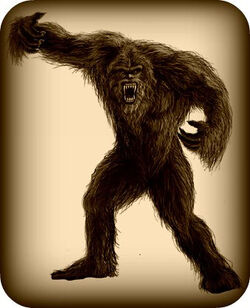
A Skookum is a variety of mountain giant or monster similar to the Sasquatch or Bigfoot. In the surviving Chinuk-Wawa dialect spoken in Grand Ronde, Oregon, this variant is pronounced differently (skoo-KOOM) but when used in English (a word for strong, powerful or monstrous) it is pronounced skoo-kuh-m. The Skookum is said to inhabit the Mount St. Helens region of Washington State, causing many deaths there.
Appearance
Natives of the Pacific Northwest depict it as a feared mountain devil which can take any shape, however in the modern version of this legend, the features of this creature are very ape-like. The Skookum seems to be parallel to Bigfoot, however this creature is extremely predatory.
Sightings

The most vivid reported sighting of a Skookum was in 1924, when a group of miners were ambushed by a massive sasquatch-like monster. The men were prospecting on the Muddy, which is a part of the Lewis River. They saw a number of huge foot imprints, but did not know what to think of them until they saw a large beast leering at them from behind a tree. Terrified, one of the men shot at the Skookum, apparently hitting it. The creature scrambled away. One of the miners, Fred Beck, says he shot one of the beasts three times and it fell into a canyon. The body was never found.
That night, it seems the Skookums decided to strike back. The miners’ accommodation was apparently attacked for around five hours, with the creatures using rocks to try to break in. The men fired shots but this seemed to have little or no effect. There were no windows in the accommodation and so the men could not see their attackers, but they said it seemed like there were more than two creatures attacking the building. There were big footprints around the building when another party of men went to investigate, but there was no other sign of the ape-like creatures.
Bigfoot researcher Henry Franzoni investigated the Skookum in the 1990s after spotting one at Skookum Lake, Oregon. He and his companion were allegedly standing not 10 feet from one of these creatures. With his interest piqued, Henry wanted to find out more and so began to collect local stories and legends, recognizing the link between the place names and the sightings. His research highlighted that there are tens of Skookum place names all over Washington State.
In September 2000, a team of researchers discovered what is now known as the Skookum Cast. The team, including Dr. Leroy Fish and Thom Powell, had mounted an expedition in the Gifford Pinchot National Forest and had been searching for evidence of a Skookum. On the seventh day, having laid a trap with bait, they found a large animal impression and took a cast of it. This full-body cast was subsequently examined by Dr. Jeff Meldrum, a professor of anatomy and anthropology at Idaho State University. Dr. Meldrum could not attribute the cast to any known Northwest animal and admitted that it could represent an unknown primate. This opinion was espoused by Dr. Grover Krantz, a retired physical anthropologist at Washington State University, and Dr. John Bindernagel, a Canadian wildlife biologist.
Detractors opine that this imprint was probably made by an elk. The print was of a body, not a footprint, and there were no related footprints found near the scene, leading some to believe that this mark was not made by a Skookum. Believers say that the animal was probably clever enough to hide its tracks. However, if this is the case, why would it leave an imprint of its body? The cast remains the source of much debate.


